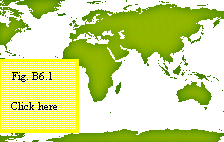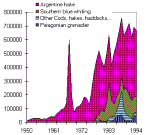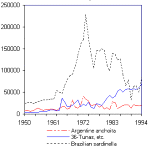FAO Fisheries Circular No. 920 FIRM/C920
Rome, 1997
ISSN 0429-9329
REVIEW OF THE STATE OF WORLD FISHERY RESOURCES: MARINE FISHERIES
by
Marine Resources Service,
Fishery Resources Division,
Fisheries Department,
FAO, Rome, Italy
6. SOUTHWEST ATLANTIC
FAO Statistical Area 41
INTRODUCTION

This Statistical Area covers a total area of 17.62 million km2 off the eastern South American coast, from northern Brazil to southern Argentina and includes a total shelf area of 1.96 million km2. In the Amazon area the continental (Figure B6.1) shelf may extend as far as 65 km (35 nm) offshore where the bottom is mostly river deposits and debris, but otherwise the shelf in the northern part is rather narrow and coraline and mostly unsuitable for trawling. The shelf continues to be narrow and rocky off central and southern Brazil, before getting wider and more easily trawlable as higher latitudes are approached. The best and largest trawling areas are found in the River Plate area and over the Patagonian shelf and the Falkland-Malvinas area, where the shelf extends well beyond the 200 nm limit (more than 370 km) off the continental coastline, turning this into the largest shelf area in the southern hemisphere.
The type of fisheries and the variety and abundance of exploited fishery resources within this area are determined by the topography and other physical characteristics, including the differences in environmental conditions, which range from typically tropical in the north to sub-Antarctic in the south. Shrimps and lobsters, and to a lesser extent reef fishes and other tropical demersals, tend to be of particular relevance towards the northern part of the area. Small pelagics sustain an important fishery in nutrient-rich coastal areas where water masses mix off central Brazil and are also abundant in the River Plate area. Coastal demersals are particularly important off southern Brazil and in the River Plate area, while mid- and deep-water demersals tend to dominate the scene over most of the River Plate, the Patagonian and Falklands-Malvinas shelf area, where there is also an important squid fishery. Large pelagics are mostly caught off central Brazil and the River Plate area.
PROFILE OF CATCHES
Figure B6.2
 Total fish production in this area comes mostly from demersals, and more recently
from squids, mainly caught in the southern Patagonian shelf area. This is
one of the Statistical Areas where capture fisheries have seen a rapid development
in terms of total production, with a more or less sustained rate of increase
in recent years. In 1950, when most known fish stocks in the area were reported
as lightly exploited or virtually unexploited, the total catch for the whole
area was only 170 000 t. Several new fisheries have developed since, and total
catches have increased consistently at an average rate of 9% per year, to
reach a maximum of 2.4 million t in 1987. Then total catches level off, to
decline slightly to 2.1 million t in 1994. Except for the burst in catches
in 1967 caused by an intense pulse fishing of hake and other demersals by
an ex-USSR fleet, total annual catches by year and major ISSCAAP group increased
almost steadily between 1950 and 1987, to decline with some year-to-year fluctuations
toward 1994 (Figure B6.2 and Table
VI).
Total fish production in this area comes mostly from demersals, and more recently
from squids, mainly caught in the southern Patagonian shelf area. This is
one of the Statistical Areas where capture fisheries have seen a rapid development
in terms of total production, with a more or less sustained rate of increase
in recent years. In 1950, when most known fish stocks in the area were reported
as lightly exploited or virtually unexploited, the total catch for the whole
area was only 170 000 t. Several new fisheries have developed since, and total
catches have increased consistently at an average rate of 9% per year, to
reach a maximum of 2.4 million t in 1987. Then total catches level off, to
decline slightly to 2.1 million t in 1994. Except for the burst in catches
in 1967 caused by an intense pulse fishing of hake and other demersals by
an ex-USSR fleet, total annual catches by year and major ISSCAAP group increased
almost steadily between 1950 and 1987, to decline with some year-to-year fluctuations
toward 1994 (Figure B6.2 and Table
VI).
At the ISSCAAP Group level, the major contributors to the total catches are the demersals in Group 32 (cods, hakes, etc.) and molluscs in Group 57 (squids, etc.), followed by the demersals in Group 33 (redfishes, basses, congers, etc.), the small pelagics in Group 35 (herrings, sardines, anchovies, etc.), and other demersals in Group 38 (sharks, rays, chimaeras, etc.). At the single species group level, the dominant species in terms of volume are the Argentine hake (Merluccius hubsii) and the southern blue whiting (Micromesistius australis) in the demersals ISSCAAP Group 32, the Argentine shortfin squid (Illex argentinus) in ISSCAAP Group 57, and the Brazilian sardinella (Sardinella brasiliensis) in the small pelagic ISSCAAP Group 35.
Figure B6.3
 The Argentine hake (Merluccius hubsii) sustains one of the most important
fisheries in the River Plate area and over most of the Patagonian shelf. After
reaching a maximum of 520 000 t in 1991, annual catches of this species leveled
off and are now diminishing slightly (Fig. B6.3).
However, it is still the main single species with the highest catches in the
area. Other deep-water demersals in the ISSCAAP Group 32 which make a significant
contribution to the total catches in the area are the southern blue whiting
(Micromesistius australis) and the Patagonian grenadier (Macruronus
magellanicus) (Fig. B6.3). These are particularly
abundant in the Southern Patagonian shelf and slope area, where they are exploited
by long range fleets from the region as well as from distant areas.
The Argentine hake (Merluccius hubsii) sustains one of the most important
fisheries in the River Plate area and over most of the Patagonian shelf. After
reaching a maximum of 520 000 t in 1991, annual catches of this species leveled
off and are now diminishing slightly (Fig. B6.3).
However, it is still the main single species with the highest catches in the
area. Other deep-water demersals in the ISSCAAP Group 32 which make a significant
contribution to the total catches in the area are the southern blue whiting
(Micromesistius australis) and the Patagonian grenadier (Macruronus
magellanicus) (Fig. B6.3). These are particularly
abundant in the Southern Patagonian shelf and slope area, where they are exploited
by long range fleets from the region as well as from distant areas.
Figure B6.5
 The main species within ISSCAAP Group 35 are the Brazilian sardinella and
the Argentine anchoita. Catches of tunas and other large pelagics in ISSCAAP
Group 36 (Fig. B6.5) are increasing slowly in
the area (Figure B6.5).
The main species within ISSCAAP Group 35 are the Brazilian sardinella and
the Argentine anchoita. Catches of tunas and other large pelagics in ISSCAAP
Group 36 (Fig. B6.5) are increasing slowly in
the area (Figure B6.5).
Another very important fishery in this area is that for squids, mostly Argentine shortfin squid (Illex argentinus) and common squid (Loligo sp.). The overall abundance and actual catches of these species have been very variable since the fisheries started some 10-15 years ago, and after reaching a maximum of 760 000 in 1989 total catches have declined to 560 000 t in 1994 (Table VI).
Within ISSCAAP Group 45, it is noteworthy that shrimps, prawns, lobsters and crabs sustain important fisheries in the whole area, from the tropical to the sub-Antarctic zone. Altogether this species group has been yielding total catches of almost 100 000 t per year, an important figure considering their high market value. In most cases these stocks are considered to be fully to over-exploited.
Also noteworthy is that around 10% of the total catches in this Area are reported as unidentified fish, or "marine fishes nei" in the official statistics, grouped here under ISSCAAP Group 39 (miscellaneous marine fishes) in Figure B6.2 and Table VI. While this lack of accuracy in the reporting of catch statistics by species is not as serious as in other less-developed areas, it is still an indication of weaknesses in the species identification and catch-reporting systems at national level and of difficulties and uncertainties regarding the assessment and management of some fisheries and fish stocks in the area. Reported catches in ISSCAAP Group 39 have been increasing slightly, following the same general trend as the other, better identified species groups. In 1994 the total catch in this category amounted to 210 000 t, of which more than 190 000 t were reported by Brazil, followed by Rep. of Korea and Uruguay.
There is also some reporting of non-identified species within the other ISSCAAP Groups, and of particular relevance are the reported catches of unidentified squids (squids nei) in ISSCAAP Group 57. In some years this group accounted for more than 50% of the total squid catches in the area, while in 1994 the reported catches of unidentified squids added 257 000 t, out of a total of 563 000 t for the whole squid group. These catches were reported mainly by Japan, Rep. of Korea, Russian Fed., Spain and Lithuania. Most, if not all, of these unidentified squid catches are believed to be either the Argentinean shortfin squid (Illex argentinus) or the common squid (Loligo sp.). Most of the catches of unidentified fish from Brazil and Uruguay seem to come from poorly monitored coastal small-scale fisheries, while those by distant-water countries come from long range industrial fleets.
Prior to the 1970s, most of the catches in this area were reported by coastal states, with no more than 2% of the total being caught by long range fleets from other nations. This changed, and temporarily increased to more than 60% in 1967 during the short-term pulse fishing exerted by the ex-USSR. The proportion taken by long-range foreign fleets then started to increase steadily from 5% in 1972 to 50% in 1987, to then drop to 28% in 1994. Most of these catches by nations from outside the region are deep-water demersals and squids taken in the southern Patagonian shelf area or tunas taken elsewhere.
RESOURCES STATUS AND MANAGEMENT
Until the early 1980s this area was amongst the few major fishing areas of the world with a large potential for expansion, with a few stocks still falling under the general category of underexploited or lightly exploited stocks. Several mostly industrialized long-range fisheries have develop since, and most of the fish stocks are now considered to be fully exploited, while some are, or have been, overexploited during the past few years.
While there is a growing concern over the state of exploitation of some fish stocks, the amount of updated hard evidence on the assessment and management of fish stocks and fisheries for the area seems to have diminished in recent years. To a great extent this has to do with the slowing down in the activities of organizations or working groups that either directly, or through scientific or technical meetings and publications, used to look into and report on stock assessment and fisheries management-related issues in the area.
The Joint Technical Commission for the River Plate Maritime Front ("Frente Maritimo"), based in Montevideo, Uruguay, has been very active in promoting bilateral cooperation between neighboring Argentina and Uruguay regarding the assessment and management of shared fish stocks and in promoting scientific meetings and publications of regional and international relevance, where various stock assessment and fisheries management issues used to be addressed and discussed. Due to various reasons, most of these activities have been suspended or reduced in recent years.
Argentina and the United Kingdom are also co-operating in the assessment and management of fish stocks and fisheries in the Falklands-Malvinas area, and this has resulted in the adoption of some coordinated management measures to restrict access and regulate fishing effort in neighboring fishing grounds, including voluntary restrictions in fishing grounds located beyond the 200-mile limit. While it is known that fisheries in the area are closely monitored and assessed, sometimes at a bilateral level, the results of these assessments are however not readily available outside specific bilateral meetings.
Brazil also used to have some 10 permanent working groups that were responsible for providing advice on the management and development of fisheries along the Brazilian coast, but they have been inactive in recent years. Some fruitful results have, however, been achieved, and contributed to improve the assessment and management of shrimp resources in the northernmost part of Area 41, in the Guyana-Brazil area, within the context of the Western Central Atlantic Fisheries Commission (WECAFC).
As mentioned above, most of the reported expansion in production in this area is due to the increased catches of hake and, more recently, of other demersals and squids caught in the Patagonian shelf and slope area. The available assessments and information on exploitation rates indicate that the Argentine hake stock is fully exploited and probably has been slightly overexploited during some years. The fishing grounds of Argentinian hake overlap over the outer Patagonian shelf and slope with that of the Patagonian hake (Merluccius polylepis), from which it can hardly be distinguished from simple observation in the commercial catches. It is therefore believed that a small portion of catches reported as Argentinian hake are actually of Patagonian hake, which is probably in the same state of exploitation as the former
The stocks of the other major ISSCAAP Group 32 species, Southern blue whiting and the Patagonian grenadier, are moderately to fully exploited and annual catches have been slightly variable, apparently due to changes in availability and shifts in fishing pressure. In 1994 the total catch of these two species was, respectively, 105 000 t and 46 000 t.
The stocks of the main deep-water demersal species within ISSCAAP Group 33 (pink cusk eel and Patagonian toothfish) are considered to be moderately exploited. There are several stocks of the coastal demersal species of Group 33 throughout the region, and most of them seem to be moderately to fully exploited, with some local stocks probably overexploited. In 1994 the catch of the three main coastal demersals (whitemouth croaker, Argentine croaker and weakfishes) was 78 000 t, 21 000 t and 61 000 t respectively. These stocks are mostly exploited by Brazil, Argentina and Uruguay.
The Brazilian sardinella (Sardinella brasiliensis) of ISSCAAP Group 35 has been overfished for several years and has also been affected by some adverse environmental conditions. After being in the range of 120 000 t to 230 000 t per year, catches declined to 32 000 t by 1990. Although catches have recovered to 85 000 t in 1994, the stock still seems to be in poor condition. In the same general area, but further south, off Uruguay and Argentina, the Argentine anchoita (Engraulis anchoita) is one of the few cases left of an underexploited stock. While catches of this species have been stable in the order of 20 000 t per year, available estimates suggest a potential several times higher.
The total catch of tunas (ISSCAAP Group 36) was 70 000 t in 1994, and although there are no specific assessments of the state of these stocks, there might still be some room for further expansion. Catches of sharks and rays have also been increasing slightly, to almost 55 000 t in 1994. No assessments are available for these stocks in this area either. The main stocks of squid are found on the Patagonian shelf and slope area and are exploited by long range fleets from different nationalities. They are most likely fully to over-exploited.
While enforcement is not always as effective as desirable, most of these fisheries are under some kind of management scheme, with specific management measures that vary from one country to country and from one stock to another. Only a few fisheries are under an open access regime, and these are mostly coastal small-scale fisheries. In most cases there is some kind of limited access scheme, often combined with nominal fishing effort and/or total allowable catch (TAC) limits to keep fishing mortality under control, and minimum size limits or seasonal closures to protect juveniles and spawners. The hake fishery is regulated by an annual TAC, and minimum mesh size limits are in force to keep the capture of juveniles down. Some incidence of discards has however been reported and seems to be a problem that needs to be addressed. Similar management measures are adopted for other demersals, while squids are mostly managed through annual fishing licences and TACs geared to ensure a minimum escapement each year. Shrimps, lobsters and other crustacean fisheries are mostly regulated by closed seasons and areas and minimum size limits.